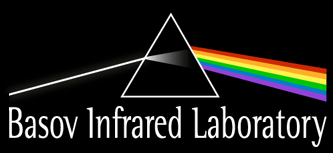Correlated Electron Systems
The physics of materials with strong electronic correlations is remarkably rich and complex and cannot be understood within the conventional theories of metals and insulators. In correlated materials, charge, spin, orbital and lattice degrees of freedom result in competing interactions. These lead to phase transitions and the emergence of exotic phases including the pseudogap state in cuprates and manganites, high-temperature superconductivity, charge stripes in cuprates, even phase separation in some manganites and cuprates.
Recent review articles: Refs. 149, 146, 76 and also: http://dx.doi.org/10.1088/0034-4885/80/1/014501
Highlights:
Good plasmons in a bad metal
Francesco L. Ruta et al. Science 387, 786-791 (2025). Ref. [371].
Details
 Correlated metals may exhibit unusually high resistivity that increases linearly in temperature, breaking through the Mott-Ioffe-Regel bound, above which coherent quasiparticles are destroyed. The fate of collective charge excitations, or plasmons, in these systems is a subject of debate. Several studies have suggested that plasmons are overdamped, whereas other studies have detected propagating plasmons. In this work, we present direct nano-optical images of low-loss hyperbolic plasmon polaritons (HPPs) in the correlated van der Waals metal MoOCl2. HPPs are plasmon-photon modes that waveguide through extremely anisotropic media and are remarkably long-lived in MoOCl2. Photoemission data presented here reveal a highly anisotropic Fermi surface, reconstructed and made partly incoherent, likely through electronic interactions as explained by many-body theory. HPPs remain long-lived despite this, revealing previously unseen imprints of many-body effects on plasmonic collective modes.
Correlated metals may exhibit unusually high resistivity that increases linearly in temperature, breaking through the Mott-Ioffe-Regel bound, above which coherent quasiparticles are destroyed. The fate of collective charge excitations, or plasmons, in these systems is a subject of debate. Several studies have suggested that plasmons are overdamped, whereas other studies have detected propagating plasmons. In this work, we present direct nano-optical images of low-loss hyperbolic plasmon polaritons (HPPs) in the correlated van der Waals metal MoOCl2. HPPs are plasmon-photon modes that waveguide through extremely anisotropic media and are remarkably long-lived in MoOCl2. Photoemission data presented here reveal a highly anisotropic Fermi surface, reconstructed and made partly incoherent, likely through electronic interactions as explained by many-body theory. HPPs remain long-lived despite this, revealing previously unseen imprints of many-body effects on plasmonic collective modes.
Electronic interactions in Dirac fluids visualized by nano-terahertz spacetime interference of electron-photon quasiparticles
Suheng Xu et al, Science Advances 10, eado5553 (2024) Ref. [365]
Details
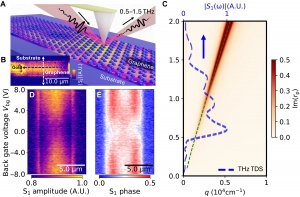 Ultraclean graphene at charge neutrality hosts a quantum critical Dirac fluid of interacting electrons and holes. Interactions profoundly affect the charge dynamics of graphene, which is encoded in the properties of its electron-photon collective modes: surface plasmon polaritons (SPPs). Here, we show that polaritonic interference patterns are particularly well suited to unveil the interactions in Dirac fluids by tracking polaritonic interference in time at temporal scales commensurate with the electronic scattering. Spacetime SPP interference patterns recorded in terahertz (THz) frequency range provided unobstructed readouts of the group velocity and lifetime of polariton that can be directly mapped onto the electronic spectral weight and the relaxation rate. Our data uncovered prominent departures of the electron dynamics from the predictions of the conventional Fermi-liquid theory. The deviations are particularly strong when the densities of electrons and holes are approximately equal. The proposed spacetime imaging methodology can be broadly applied to probe the electrodynamics of quantum materials.
Ultraclean graphene at charge neutrality hosts a quantum critical Dirac fluid of interacting electrons and holes. Interactions profoundly affect the charge dynamics of graphene, which is encoded in the properties of its electron-photon collective modes: surface plasmon polaritons (SPPs). Here, we show that polaritonic interference patterns are particularly well suited to unveil the interactions in Dirac fluids by tracking polaritonic interference in time at temporal scales commensurate with the electronic scattering. Spacetime SPP interference patterns recorded in terahertz (THz) frequency range provided unobstructed readouts of the group velocity and lifetime of polariton that can be directly mapped onto the electronic spectral weight and the relaxation rate. Our data uncovered prominent departures of the electron dynamics from the predictions of the conventional Fermi-liquid theory. The deviations are particularly strong when the densities of electrons and holes are approximately equal. The proposed spacetime imaging methodology can be broadly applied to probe the electrodynamics of quantum materials.
Inhomogeneous Photosusceptibility of VO2 Films at the Nanoscale
Sternbach et al, Physical Review Letters, 132, 186903 (2024) Ref. [361]
Details
 Pump-probe nano-optical experiments were used to study the light-induced insulator to metal transition (IMT) in thin films of vanadium dioxide (VO2), a prototypical correlated electron system. We show that inhomogeneous optical contrast is prompted by spatially uniform photoexcitation, indicating an inhomogeneous photosusceptibility of VO2. We locally characterize temperature and time dependent variations of the photoexcitation threshold necessary to induce the IMT on picosecond timescales with hundred nanometer spatial resolution. We separately measure the critical temperature 𝑇𝐿, where the IMT onsets and the local transient electronic nano-optical contrast at the nanoscale. Our data reveal variations in the photosusceptibility of VO2 within nanoscopic regions characterized by the same critical temperature 𝑇𝐿 where metallic domains can first nucleate.. This work has been highlighted by Silke Paschen and Qimiao Si, Nature Reviews Physics, 3, 9 (2021).
Pump-probe nano-optical experiments were used to study the light-induced insulator to metal transition (IMT) in thin films of vanadium dioxide (VO2), a prototypical correlated electron system. We show that inhomogeneous optical contrast is prompted by spatially uniform photoexcitation, indicating an inhomogeneous photosusceptibility of VO2. We locally characterize temperature and time dependent variations of the photoexcitation threshold necessary to induce the IMT on picosecond timescales with hundred nanometer spatial resolution. We separately measure the critical temperature 𝑇𝐿, where the IMT onsets and the local transient electronic nano-optical contrast at the nanoscale. Our data reveal variations in the photosusceptibility of VO2 within nanoscopic regions characterized by the same critical temperature 𝑇𝐿 where metallic domains can first nucleate.. This work has been highlighted by Silke Paschen and Qimiao Si, Nature Reviews Physics, 3, 9 (2021).
Electronic Correlations in Nodal-Line Semimetals
Shao et al, Nature Physics, 16, 636 (2020) Ref. [282]
Details
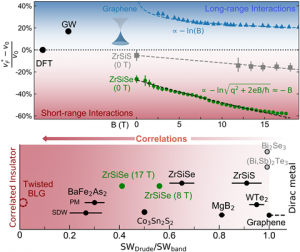 Three-dimensional (3D) Dirac fermions with highly-dispersive linear bands are usually considered weakly correlated, due to relatively large bandwidths (W) compared to Coulomb interactions (U). With the discovery of nodal-line semimetals, the notion of Dirac dispersion has been extended to lines and loops in the momentum space. The anisotropy associated with nodal-line structure gives rise to greatly reduced kinetic energy along the line. Here we report on prominent correlation effects in a nodal-line semimetal compound ZrSiSe through a combination of optical spectroscopy and density-functional-theory calculations. We observed two fundamental spectroscopic hallmarks of electronic correlations: strong reduction (1/3) of the free carrier Drude weight (bottom left) and of the Fermi velocity (top left) compared to predictions of density functional band theory. Interestingly, the suppression of the Fermi velocity is futher tunable with external magnetic field.
Three-dimensional (3D) Dirac fermions with highly-dispersive linear bands are usually considered weakly correlated, due to relatively large bandwidths (W) compared to Coulomb interactions (U). With the discovery of nodal-line semimetals, the notion of Dirac dispersion has been extended to lines and loops in the momentum space. The anisotropy associated with nodal-line structure gives rise to greatly reduced kinetic energy along the line. Here we report on prominent correlation effects in a nodal-line semimetal compound ZrSiSe through a combination of optical spectroscopy and density-functional-theory calculations. We observed two fundamental spectroscopic hallmarks of electronic correlations: strong reduction (1/3) of the free carrier Drude weight (bottom left) and of the Fermi velocity (top left) compared to predictions of density functional band theory. Interestingly, the suppression of the Fermi velocity is futher tunable with external magnetic field.
Multi-messenger nanoprobes of hidden magnetism in a strained manganite
McLeod et al. Nature Materials, 19, 397, (2019). Ref. [279]
Details
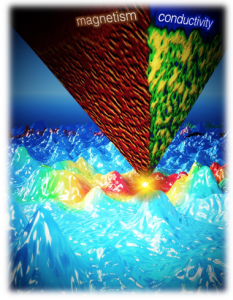 The unique physical properties of correlated electron materials often arise from interactions among disparate degrees of freedom, such as charge, spin, and lattice distortions. Owing to these interactions, conductivity in thin films of the “colossal magnetoresistive” rare earth manganite La2/3Ca1/3MnO3 can be disabled by epitaxial strain, but curiously restored with ultrafast optical pulses. By combining cryogenic near-field infrared and magnetic force microscopies, we leverage multi-messenger nano-imaging to simultaneously interrogate several interacting orders, here metallic conductivity and magnetism, in individual domains of the photo-induced hidden phase. We reveal a light-induced ferromagnetic metal distinct from its strain-free counterpart, and “erasable” through delivery of nano-scale strain from the nano-imaging probe.
The unique physical properties of correlated electron materials often arise from interactions among disparate degrees of freedom, such as charge, spin, and lattice distortions. Owing to these interactions, conductivity in thin films of the “colossal magnetoresistive” rare earth manganite La2/3Ca1/3MnO3 can be disabled by epitaxial strain, but curiously restored with ultrafast optical pulses. By combining cryogenic near-field infrared and magnetic force microscopies, we leverage multi-messenger nano-imaging to simultaneously interrogate several interacting orders, here metallic conductivity and magnetism, in individual domains of the photo-induced hidden phase. We reveal a light-induced ferromagnetic metal distinct from its strain-free counterpart, and “erasable” through delivery of nano-scale strain from the nano-imaging probe.
Coexisting first-and second-order electronic phase transitions in a correlated oxide NdNiO3
Post et al. Nature Physics 14, 1056 (2018). Ref. [262]
Details
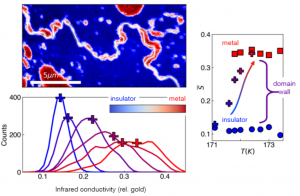 By harnessing a nanoscale optical probe of the local electronic conductivity, we reveal two physically distinct yet concurrent low-temperature phase transitions in the rare earth nickelate NdNiO3. Whereas the sample bulk exhibits a first-order transition between metal and insulator phases, we resolve anomalous nanoscale domain walls in the insulating state that undergo a distinctly continuous insulator–metal transition, with hallmarks of second-order behaviour. We ascribe these domain walls to boundaries between antiferromagnetically ordered domains within the charge ordered bulk. The close correspondence of these observations to predictions from a Landau theory of coupled charge and magnetic orders highlights the importance of coupled order parameters in driving the complex phase transition in correlated electron materials such as the rare earth nickelates.
By harnessing a nanoscale optical probe of the local electronic conductivity, we reveal two physically distinct yet concurrent low-temperature phase transitions in the rare earth nickelate NdNiO3. Whereas the sample bulk exhibits a first-order transition between metal and insulator phases, we resolve anomalous nanoscale domain walls in the insulating state that undergo a distinctly continuous insulator–metal transition, with hallmarks of second-order behaviour. We ascribe these domain walls to boundaries between antiferromagnetically ordered domains within the charge ordered bulk. The close correspondence of these observations to predictions from a Landau theory of coupled charge and magnetic orders highlights the importance of coupled order parameters in driving the complex phase transition in correlated electron materials such as the rare earth nickelates.
Nanotextured Phase Coexistence in the Correlated Insulator V2O3
McLeod et al. Nature Physics, 13, 80 (2017). Ref. [234]
Details
 The insulator–metal transition remains among the most studied phenomena in correlated electron physics. However, the spontaneous formation of spatial patterns amidst insulator–metal phase coexistence remains poorly explored at the meso and nanoscales. Here we present real-space evolution of the insulator–metal transition in a V2O3 thin film imaged at high spatial resolution by cryogenic near-field infrared microscopy. We resolve spontaneously nanotextured coexistence of metal and correlated Mott insulator phases near the insulator-to-metal transition (160–180 K) associated with percolation and an underlying structural phase transition. A quantitative analysis of nano-infrared images acquired across the transition suggests decoupling of electronic and structural transformations.
The insulator–metal transition remains among the most studied phenomena in correlated electron physics. However, the spontaneous formation of spatial patterns amidst insulator–metal phase coexistence remains poorly explored at the meso and nanoscales. Here we present real-space evolution of the insulator–metal transition in a V2O3 thin film imaged at high spatial resolution by cryogenic near-field infrared microscopy. We resolve spontaneously nanotextured coexistence of metal and correlated Mott insulator phases near the insulator-to-metal transition (160–180 K) associated with percolation and an underlying structural phase transition. A quantitative analysis of nano-infrared images acquired across the transition suggests decoupling of electronic and structural transformations.
Cooperative photoinduced metastable phase control in strained manganite films
(with R.A. Averitt) Zhang et al. Nature Materials 15, 956 (2016). Ref. [229].
Details
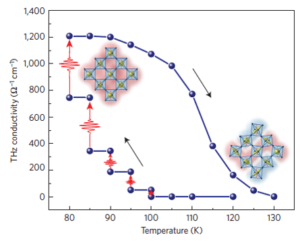 A major challenge in quantum materials is active control of quantum phases. Dynamic control with pulsed electromagnetic fields can overcome energetic barriers, enabling access to transient or metastable states that are not thermally accessible. Here we demonstrate strain-engineered tuning of La2/3Ca1/3MnO3 into an emergent charge-ordered insulating phase, where a single optical pulse can initiate a transition to a long-lived metastable hidden metallic phase. Comprehensive single-shot pulsed excitation measurements demonstrate that the transition is cooperative and ultrafast, requiring a critical absorbed photon density to activate local charge excitations that mediate magnetic–lattice coupling.
A major challenge in quantum materials is active control of quantum phases. Dynamic control with pulsed electromagnetic fields can overcome energetic barriers, enabling access to transient or metastable states that are not thermally accessible. Here we demonstrate strain-engineered tuning of La2/3Ca1/3MnO3 into an emergent charge-ordered insulating phase, where a single optical pulse can initiate a transition to a long-lived metastable hidden metallic phase. Comprehensive single-shot pulsed excitation measurements demonstrate that the transition is cooperative and ultrafast, requiring a critical absorbed photon density to activate local charge excitations that mediate magnetic–lattice coupling.
Stripes and anisotropic electronic transport in VO2
Liu et al. Physical Review Letters 111, 096603 (2013) . Ref. [182].
Details
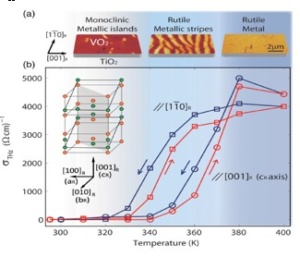 The insulator–metal transition remains among the most studied phenomena in correlated electron physics. However, the spontaneous formation of spatial patterns amidst insulator–metal phase coexistence remains poorly explored at the meso and nanoscales. Here we present real-space evolution of the insulator–metal transition in a V2O3 thin film imaged at high spatial resolution by cryogenic near-field infrared microscopy. We resolve spontaneously nanotextured coexistence of metal and correlated Mott insulator phases near the insulator-to-metal transitio (160–180 K) associated with percolation and an underlying structural phase transition. A quantitative analysis of nano-infrared images acquired across the transition suggests decoupling of electronic
The insulator–metal transition remains among the most studied phenomena in correlated electron physics. However, the spontaneous formation of spatial patterns amidst insulator–metal phase coexistence remains poorly explored at the meso and nanoscales. Here we present real-space evolution of the insulator–metal transition in a V2O3 thin film imaged at high spatial resolution by cryogenic near-field infrared microscopy. We resolve spontaneously nanotextured coexistence of metal and correlated Mott insulator phases near the insulator-to-metal transitio (160–180 K) associated with percolation and an underlying structural phase transition. A quantitative analysis of nano-infrared images acquired across the transition suggests decoupling of electronic
and structural transformations.
Mott physics near the insulator to metal transition in NdNiO3
Stewart et al. Physical Review Letters 107, 176401 (2011). Ref. [153].
Details
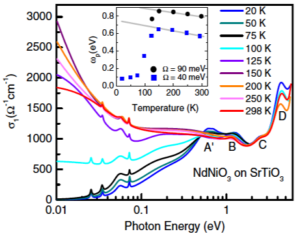 An optical study of NdNiO3 ultrathin films with insulating and metallic ground states reveals new aspects of the insulator-to-metal transition that point to Mott physics as the driving force. In contrast with the behavior of charge-ordered systems, we find that the emergence of the Drude resonance across the transition is linked to a spectral weight transfer over an energy range of the order of the Coulomb repulsion U, as the energy gap is filled with states instead of closing continuously. The simple band picture based solely on charge-ordering fails to account for the salient spectral properties of NdNiO3 and Mott physics must therefore be taken into account to fully describe this correlated system.
An optical study of NdNiO3 ultrathin films with insulating and metallic ground states reveals new aspects of the insulator-to-metal transition that point to Mott physics as the driving force. In contrast with the behavior of charge-ordered systems, we find that the emergence of the Drude resonance across the transition is linked to a spectral weight transfer over an energy range of the order of the Coulomb repulsion U, as the energy gap is filled with states instead of closing continuously. The simple band picture based solely on charge-ordering fails to account for the salient spectral properties of NdNiO3 and Mott physics must therefore be taken into account to fully describe this correlated system.

